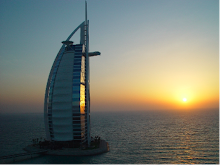To reiterate on the previous posting, one of the major goals of this blog will be to dissuade the common Western stereotypical thought concerning the region. As unfortunate as stereotyping is, it is a reality, often fueled by widespread misinformation and the media. When I tell my close friends and co workers about my directed study research, their initial reaction is generally unenthusiastic. However, as soon as I bring up the theme of my study, and discuss the importance of studying the rising economies of this region, and the fact that I will not be researching the conflict areas, the attention tends to be regained. I do not have any particular reason for reactions such as this, but I will attribute much of the American perspective on the region to the horrific events that occurred on 9/11/2001. Unfortunately, racism and hatred are almost always a result of such epic events as 9/11, and many individuals in America were persecuted for their skin color, Arabic decent and especially religion. This is inevitable, but as we move further away from this date, we as a nation are beginning to learn more about the tremendous opportunities and resources available to the world in this region of the Middle East.
Islam is the major religion in the Middle East, and has shaped much of the culture as it exists today. I will examine the difficulties many locals are having with the surge of western ideas and influence, and especially the economical impacts the transition has had on the culture.
I will also discuss the multi-faceted societies of this region, and examine the movement of millions of foreigners into the region. Dubai, for example, is transforming into more of an ethnic melting pot as New York City was back in the late 19th and early 20th centuries with tens of thousands of immigrants making the move to the city of opportunity. In fact, just 17% of the actual population of the Dubai Emirate is of native Arabic decent. The remainder is comprised mainly of Indian (51%), Southeast Asian (24%) and increasingly Eastern European. Immigrants come in search of steady labor in the many thousands of construction projects, as well as those seeking lucrative investment opportunities.
-KD
Monday, January 28, 2008
Subscribe to:
Post Comments (Atom)



No comments:
Post a Comment